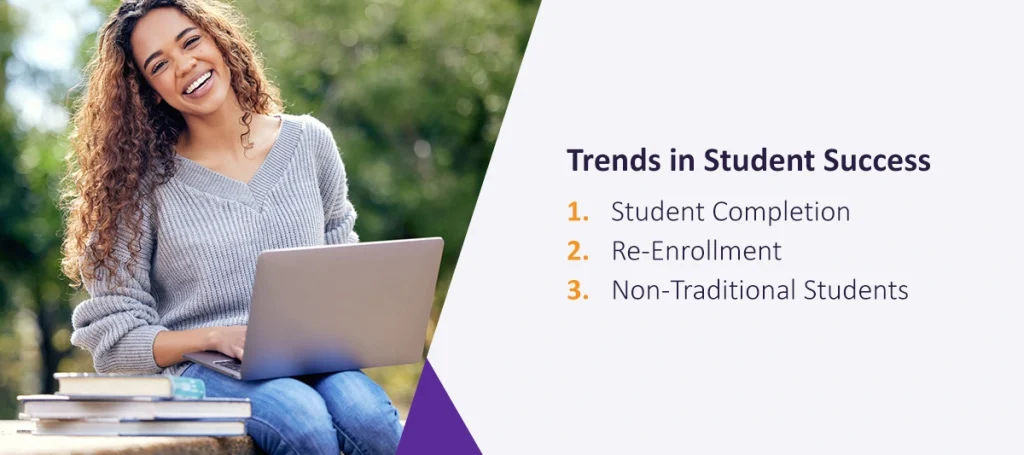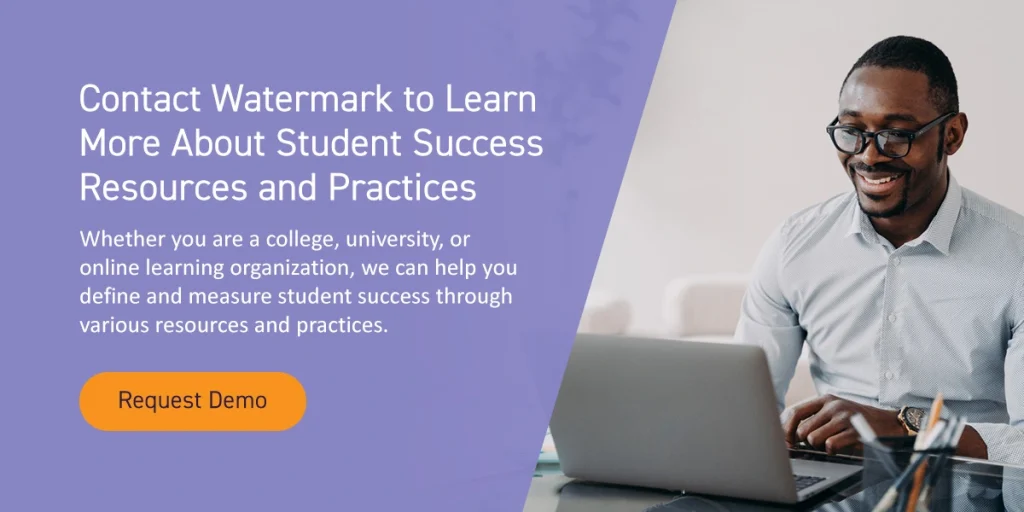




Watermark Vice President for Client Success Heather Taynor is highly regarded in higher education and student success best practices, with nearly two decades in various higher education roles. Heather’s expertise in higher education includes a full range of operational functions emphasizing building, developing, and training successful teams to support students throughout the student lifecycle.
We’ve curated some of her research-based best practices and training materials and turned them into a blog series to share with institutions, along with additional research and work from our Watermark (formerly Aviso Retention) data science team. The ultimate goal is to equip individuals to create and execute long-term student success strategies that benefit the institution and its students.
Finding ways to achieve student success may be challenging for many institutions, but taking the time and effort to establish clear paths for success can help your organization support its students at every step.
A first step for institutions focused on improving student success outcomes is developing the institution’s definition of success. Once the definitions have been established, the institution can create a genuinely student-focused strategy. The institution should align these student-centered strategies to holistically focus on the student lifecycle and those most critical to student success. In addition, all parts of the institution’s strategy must work together to support successful student outcomes.
While technology is crucial in accelerating the focus on student success, there does need to be continuous education and communication with the staff and faculty about processes and expectations. Institutions should promote transparency among departments and a holistic approach to student success. The strategy should focus on a solid student-centered process focused on a commitment to excellence where people understand how they can best support students, what needs to be done to help students succeed, and ultimately what is in the best interest of students.
Look deeper into aligning your institution with effective student support. Begin with an overall student success strategy and focus on people, processes, and technology.
Students and colleges succeed with their people. Success starts with an organizational commitment to student success and strategic direction to help accelerate the focus on more effectively supporting students. Support from the top down must also be provided to ensure that the institution succeeds with its people.
Institutions must understand the importance of the following:
Bottom line — there must be institutional alignment and reasonable goals set to be successful.
A clear understanding of your business process is essential for determining goals and steps for progressing with a student success strategy.
Here are a few areas in which your institution can develop a straightforward business process:
Each institution has its own DNA. The predictor variables, outreach and advising strategies, institutional initiatives, and success definitions may differ at each institution. Aligning the processes with the goals and strategy of the institution will lead to more effective results.
Support software can assist with departmental collaboration to work together more effectively. The use of the support software allows for documentation of student interactions to share essential information. The goal is to improve student support and services by having more integrated and efficient ways to track academic progress, identify concerns, and connect students with necessary services.
Technology helps to combine human intelligence, artificial intelligence, and data to communicate more efficiently with students and provide the most impactful resources, referrals, and interventions. Data-informed success coaching is essential to provide the best service possible to students.
For advisors and success coaches to shift their outreach efforts to be more proactive and transformational, they must have the data and technology to optimize their time with students. Historical information, notes, and predictive risk indicators can be combined to help them assist students with the most effective outreach and intervention strategies.

When exploring trends in student success and the best practices for assessing student success, many universities have begun to cater their services toward student-centered programs. Some growing trends in higher education show interesting details about the relationship between student success and higher education institutions.
According to the National Student Clearinghouse Research Center, the college completion rate was above 60% in 2021. Many institutions have seen increases in Black and Latinx students and adult learners who completed college at a rate of 2.5%.
Many universities have begun to use data and analytics to identify obstacles to graduation completion. For example, your institution could perform research and use reliable data to discover what factors might lead to incomplete courses, early dropouts, or increased skipped classes.
Almost one million students in 2020 and 2021 with some college experience re-enrolled in post-secondary education. Many of these students achieved their degrees. Universities can cater to students who plan to re-enroll after a few years out of college. Consider making the path towards transferring more attainable as well.
According to the National Center for Education Statistics (NCES), almost 40% of students in college are over 25 years old. Many have full or part-time jobs, attend school part-time, or are part of a minority group. The number of students of color, low-income, parents, first-generation, and LGBTQ+ students has increased. Even student learning types are changing as more and more students attend online or hybrid classes or participate in certificate or short-term credential programs.
Colleges should cater to non-traditional students by supporting them through online learning or social circumstances. For example, you can offer classes at flexible times for parents or working students. Universities can also provide childcare programs, meal flexibility, and social groups for the inclusivity of minority and LGBTQ+ students.

Contact Watermark to Learn More About Student Success Resources and Practices
Watermark has the tools and services needed to provide data collection, reliable analysis software, and measurements of student success to higher education institutions. Whether you are a college, university, or online learning organization, we can help you define and measure student success through various resources and practices. Use our services for research, learning outcomes measurement, or accreditation and assessment. Contact us today to speak to a representative or request a demonstration online.





























































































































































































































































































































































































